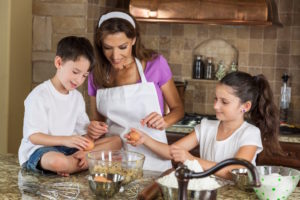
There are four basic ways we take in and process information:
- Visual involving the eyes,
- Auditory regarding hearing,
- Kinesthetic with movement
- Tactile using touch, taste and smell
Each of us has preferences in the way we take in information. Most of us are highly visual, therefore much of our learning and teaching methods are visually focused. Hearing is the next favored style, followed by movement and tactile.
In traditional educational methods, the kinesthetic and tactile methods of learning are rarely involved. Those of us who learn best with movement, touching, tasting and smelling can become bored and frustrated when our learning styles are overlooked. Children who are comfortable with visual and auditory teaching styles will also benefit from lessons that are kinesthetic and tactile.
Food preparation is one of my favorite lessons to do with children of all ages.
Cooking involves all the learning styles, and children and adults are proud and happy to share the “lesson.” Making chocolate chip cookies is an essential life skill; at least that’s my opinion.
Math, reading, following instructions, learning manners and clean-up skills are learned while engaged in a cooking lesson. We get quick feedback from our own taste buds on our job performance. If we don’t pay attention, we burn the cookies. If we don’t read or measure accurately, the cookies taste awful.
We can then use some analytical skills to figure out what went wrong. Did we include all the ingredients? Right temperature? Correct proportions? Learning is much more fun when a warm cookie is involved.
Visual learners may be concerned about the following: saving the cookies so they can show them off, watching the cookies bake, standing up high enough so they can see everything.
Auditory learners may like to sing while they work or enjoy the sounds of stirring, measuring, cracking the eggs and the thermostat in the oven clicking on.
Kinesthetic learners love to do, so they’ll want to measure, stir, drop and take the cookies off the pan, carry the cookies, open the oven door and get up and down off the kitchen stool.
Tactile learners will want to touch everything and stick their fingers in the dough, taste everything and watch other people eat and enjoy. Tactile learners may enjoy doing the dishes, which may also look like playing in the sink.
If you are aware of learning preferences, when your child starts to lose interest you can draw them back in with little “hooks” such as: Does this look right? Do you like the sound of the mixer? Do you want to stir? Can you smell the vanilla? How does this taste?
The question that gets us back on task gives us a clue to our learning preferences.
Observing your child while cooking can give you important insights about his or her learning style.
Remember the purpose of this activity is not to bake cookies, but to see what aspects of doing a new activity your child enjoys most and which parts may be frustrating or boring.
Once you have insight into your child’s learning style, you can spice things up by adding emphasis when working with them. Use learning preferences to get feedback from your children by asking: Do you see what I mean? Did you hear what I said? Can you do what I asked? How do you feel about this?
Plan activities that engage all the learning styles to optimize your child’s learning in a fun and purposeful way.
Baking and enjoying warm cookies with your family is a great way to discover learning strengths and preferences.

